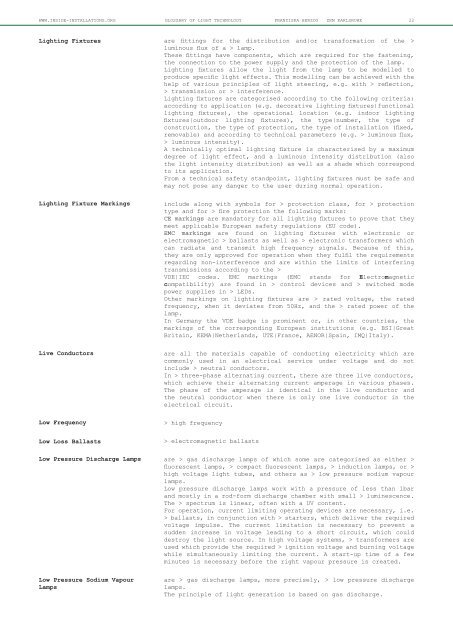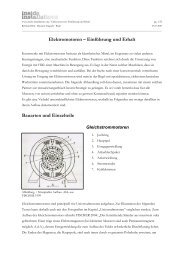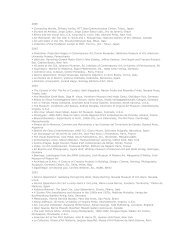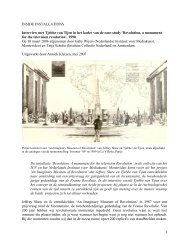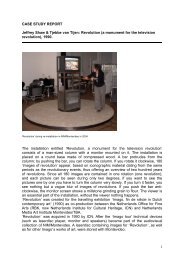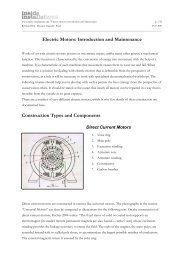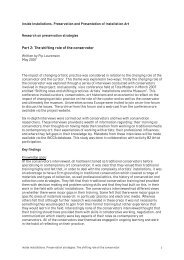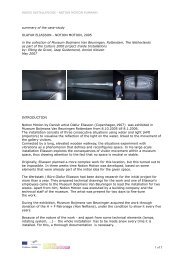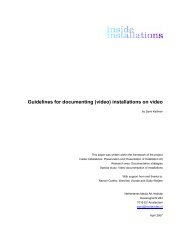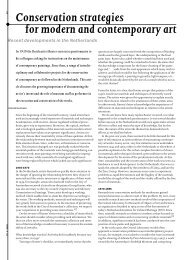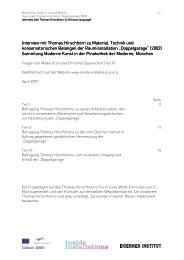GLOSSARY OF LIGHT TECHNOLOGY - Inside Installations
GLOSSARY OF LIGHT TECHNOLOGY - Inside Installations
GLOSSARY OF LIGHT TECHNOLOGY - Inside Installations
Create successful ePaper yourself
Turn your PDF publications into a flip-book with our unique Google optimized e-Paper software.
WWW.INSIDE-INSTALLATIONS.ORG <strong>GLOSSARY</strong> <strong>OF</strong> <strong>LIGHT</strong> <strong>TECHNOLOGY</strong> FRANZISKA HERZOG ZKM KARLSRUHE 22<br />
Lighting Fixtures<br />
Lighting Fixture Markings<br />
Live Conductors<br />
Low Frequency<br />
Low Loss Ballasts<br />
Low Pressure Discharge Lamps<br />
Low Pressure Sodium Vapour<br />
Lamps<br />
are fittings for the distribution and|or transformation of the ><br />
luminous flux of a > lamp.<br />
These fittings have components, which are required for the fastening,<br />
the connection to the power supply and the protection of the lamp.<br />
Lighting fixtures allow the light from the lamp to be modelled to<br />
produce specific light effects. This modelling can be achieved with the<br />
help of various principles of light steering, e.g. with > reflection,<br />
> transmission or > interference.<br />
Lighting fixtures are categorised according to the following criteria:<br />
according to application (e.g. decorative lighting fixtures|functional<br />
lighting fixtures), the operational location (e.g. indoor lighting<br />
fixtures|outdoor lighting fixtures), the type|number, the type of<br />
construction, the type of protection, the type of installation (fixed,<br />
removable) and according to technical parameters (e.g. > luminous flux,<br />
> luminous intensity).<br />
A technically optimal lighting fixture is characterised by a maximum<br />
degree of light effect, and a luminous intensity distribution (also<br />
the light intensity distribution) as well as a shade which correspond<br />
to its application.<br />
From a technical safety standpoint, lighting fixtures must be safe and<br />
may not pose any danger to the user during normal operation.<br />
include along with symbols for > protection class, for > protection<br />
type and for > fire protection the following marks:<br />
CE markings are mandatory for all lighting fixtures to prove that they<br />
meet applicable European safety regulations (EU code).<br />
EMC markings are found on lighting fixtures with electronic or<br />
electromagnetic > ballasts as well as > electronic transformers which<br />
can radiate and transmit high frequency signals. Because of this,<br />
they are only approved for operation when they fulfil the requirements<br />
regarding non-interference and are within the limits of interfering<br />
transmissions according to the ><br />
VDE|IEC codes. EMC markings (EMC stands for Electromagnetic<br />
compatibility) are found in > control devices and > switched mode<br />
power supplies in > LEDs.<br />
Other markings on lighting fixtures are > rated voltage, the rated<br />
frequency, when it deviates from 50Hz, and the > rated power of the<br />
lamp.<br />
In Germany the VDE badge is prominent or, in other countries, the<br />
markings of the corresponding European institutions (e.g. BSI|Great<br />
Britain, KEMA|Netherlands, UTE|France, AENOR|Spain, IMQ|Italy).<br />
are all the materials capable of conducting electricity which are<br />
commonly used in an electrical service under voltage and do not<br />
include > neutral conductors.<br />
In > three-phase alternating current, there are three live conductors,<br />
which achieve their alternating current amperage in various phases.<br />
The phase of the amperage is identical in the live conductor and<br />
the neutral conductor when there is only one live conductor in the<br />
electrical circuit.<br />
> high frequency<br />
> electromagnetic ballasts<br />
are > gas discharge lamps of which some are categorised as either ><br />
fluorescent lamps, > compact fluorescent lamps, > induction lamps, or ><br />
high voltage light tubes, and others as > low pressure sodium vapour<br />
lamps.<br />
Low pressure discharge lamps work with a pressure of less than 1bar<br />
and mostly in a rod-form discharge chamber with small > luminescence.<br />
The > spectrum is linear, often with a UV content.<br />
For operation, current limiting operating devices are necessary, i.e.<br />
> ballasts, in conjunction with > starters, which deliver the required<br />
voltage impulse. The current limitation is necessary to prevent a<br />
sudden increase in voltage leading to a short circuit, which could<br />
destroy the light source. In high voltage systems, > transformers are<br />
used which provide the required > ignition voltage and burning voltage<br />
while simultaneously limiting the current. A start-up time of a few<br />
minutes is necessary before the right vapour pressure is created.<br />
are > gas discharge lamps, more precisely, > low pressure discharge<br />
lamps.<br />
The principle of light generation is based on gas discharge.


